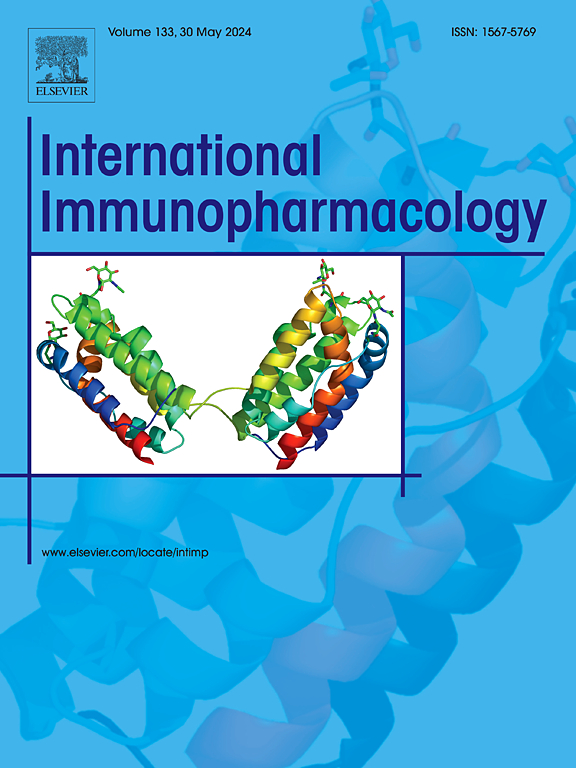Heterophyllin B alleviates cognitive disorders in APP/PS1 model mice via the spleen-gut microbiota-brain axis
IF 4.8
2区 医学
Q2 IMMUNOLOGY
引用次数: 0
Abstract
Background: Accumulating evidence implicates both the brain-spleen axis and the gut microbiota-brain axis in Alzheimer's disease (AD) pathogenesis. While our previous work demonstrated heterophyllin B (HB) rectifies splenic Th1/Th2 imbalance and ameliorates cognitive deficits in Aβ1–42-induced AD mice, its potential modulation of the vagus nerve-spleen circuit remains unexplored.
Methods: Using 8-month-old male APP/PS1 mice with/without splenic denervation (SD), we systematically investigated HB's therapeutic mechanisms via the spleen-gut microbiota-brain axis. Cognitive function was assessed through novel object recognition (ORT) and object location memory (OLT) tests. Immunofluorescence (IF) and enzyme-linked immunosorbent assay (ELISA) were employed to analyze Aβ plaques, phosphorylated tau (p-Tau) levels, and associated neuroinflammatory responses. Flow cytometry was utilized to examine the subtypes of splenic lymphocytes. Hematoxylin and eosin (H&E) staining, along with immunohistochemical (IHC) experiments, was conducted to evaluate the protective effects of HB on the intestinal barrier. Gut microbiota composition was analyzed using 16S rRNA sequencing.
Results: HB administration significantly improved cognitive performance (ORT discrimination index: +28.7 %; OLT discrimination index: +26.6 %), reduced brain and serum Aβ1–42 and p-Tau levels, downregulated the Th1/Th2 ratio in the spleen, and alleviated intestinal permeability and neuroinflammation, which were abolished in SD APP/PS1 mice. Gut microbiota shifts showed HB-induced enrichment of cognition-associated Dubosiella and Muribaculaceae, with concurrent suppression of pathogenic Lachnospiraceae_NK4A136 and ASF356.
Conclusion: This study provides first evidence that HB ameliorates AD pathology through vagus nerve-dependent regulation of the spleen-gut microbiota-brain axis, establishing its multimodal therapeutic potential for neural-immune-gut circuit modulation in neurodegenerative diseases.
求助全文
约1分钟内获得全文
求助全文
来源期刊
CiteScore
8.40
自引率
3.60%
发文量
935
审稿时长
53 days
期刊介绍:
International Immunopharmacology is the primary vehicle for the publication of original research papers pertinent to the overlapping areas of immunology, pharmacology, cytokine biology, immunotherapy, immunopathology and immunotoxicology. Review articles that encompass these subjects are also welcome.
The subject material appropriate for submission includes:
• Clinical studies employing immunotherapy of any type including the use of: bacterial and chemical agents; thymic hormones, interferon, lymphokines, etc., in transplantation and diseases such as cancer, immunodeficiency, chronic infection and allergic, inflammatory or autoimmune disorders.
• Studies on the mechanisms of action of these agents for specific parameters of immune competence as well as the overall clinical state.
• Pre-clinical animal studies and in vitro studies on mechanisms of action with immunopotentiators, immunomodulators, immunoadjuvants and other pharmacological agents active on cells participating in immune or allergic responses.
• Pharmacological compounds, microbial products and toxicological agents that affect the lymphoid system, and their mechanisms of action.
• Agents that activate genes or modify transcription and translation within the immune response.
• Substances activated, generated, or released through immunologic or related pathways that are pharmacologically active.
• Production, function and regulation of cytokines and their receptors.
• Classical pharmacological studies on the effects of chemokines and bioactive factors released during immunological reactions.

 求助内容:
求助内容: 应助结果提醒方式:
应助结果提醒方式:


